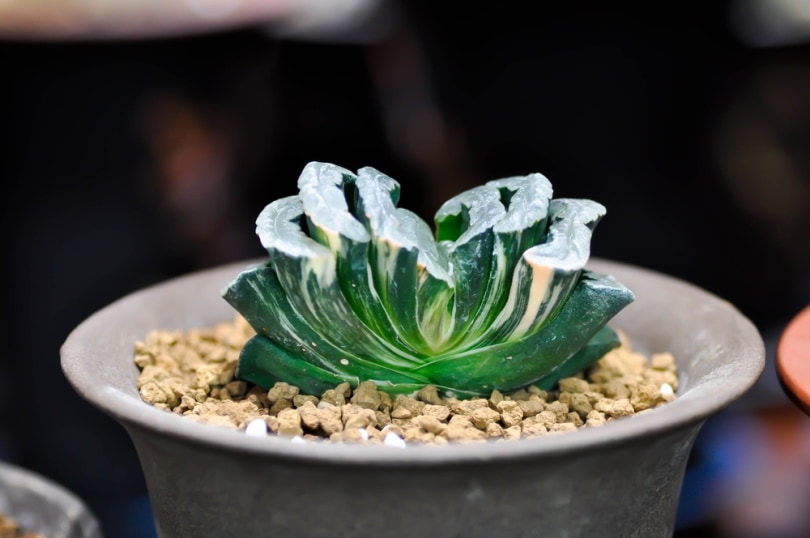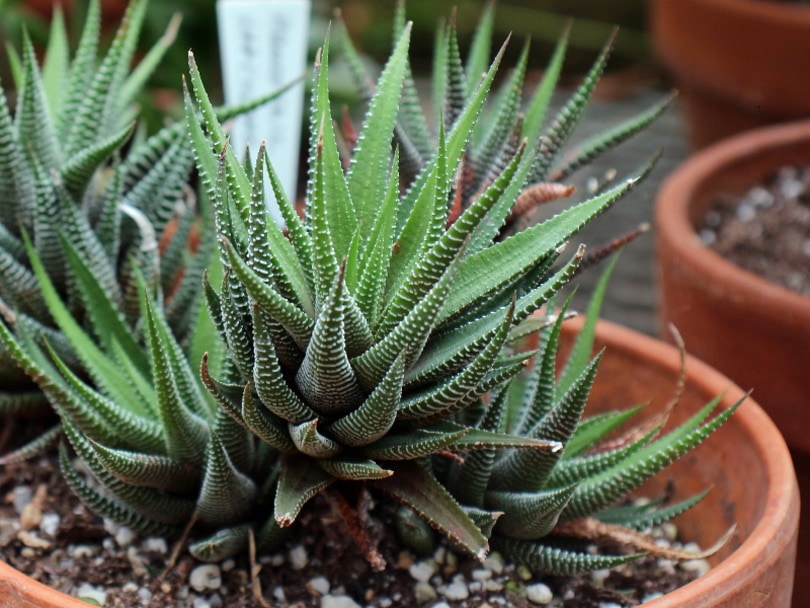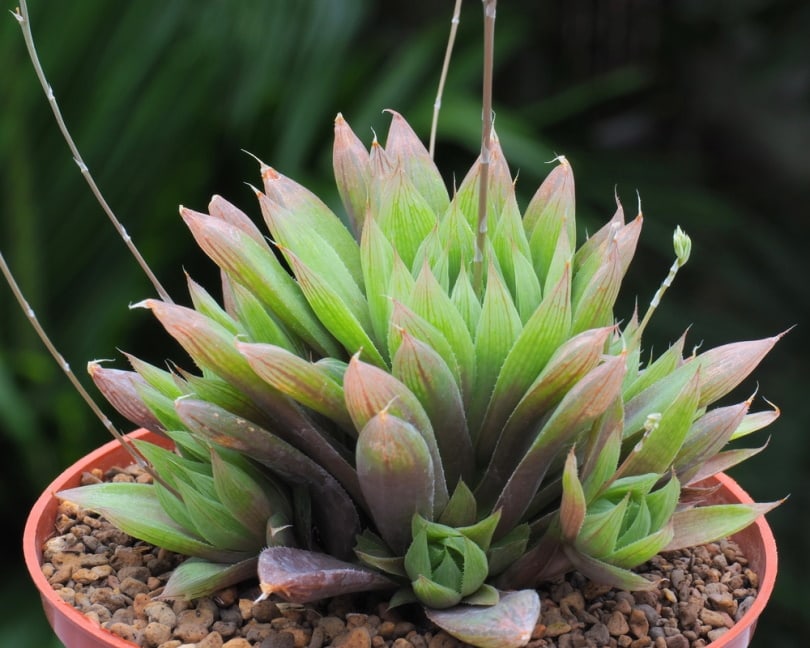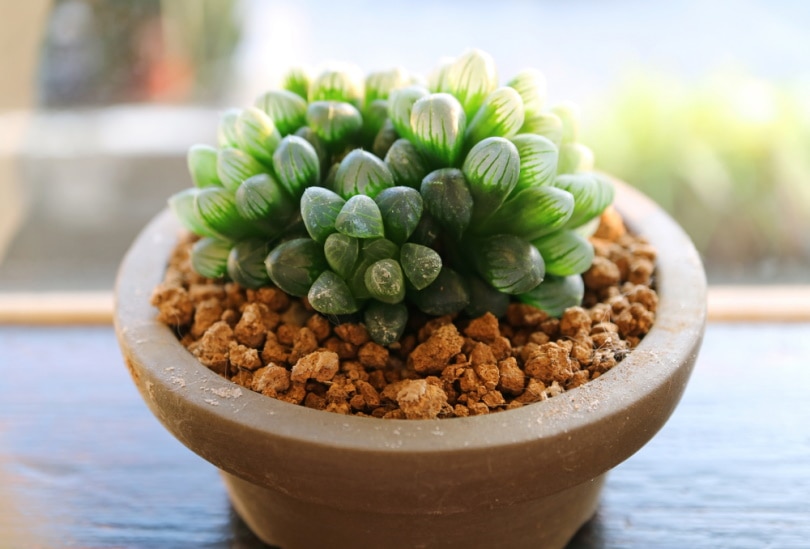7 Types of Haworthia Succulents (with Pictures)
-
Codee Chessher
- Last updated:

Haworthia is a type of small plant similar to the aloe and agave, but typically much smaller in size and with foliage variations. Haworthia hails from South Africa, but it was quickly adopted by plant enthusiasts. Most strikingly, small green or white encrustations often decorate haworthia foliage and set them apart from aloe plants.
These distinctive little succulents are the ideal low-maintenance houseplants, requiring very little water and sunlight to thrive. In fact, they require at least part-time shade to stay luscious and green. Each type of haworthia is unique, and we’ll be detailing X different types so you can choose which is perfect for your home.
Are Haworthia Succulents Like Aloe Plants?
Yes, haworthia is like aloe and agave plants. Aloe is typically larger than haworthia, and agave is larger still. The biggest difference is that, unlike aloe or agave, haworthia stays small even when mature. While many larger haworthia plants reach aloe sizes, you can tell them apart by the jewel-like encrustations along the leaves.
Another major difference is that aloe can tolerate full sunlight, even if it flourishes with partial shade. Haworthia, by contrast, can’t tolerate full sun and they’ll start to turn orange or red if deprived of sufficient shade time.
One other small difference between these genera is that aloe has toothy protrusions along its leaves, and haworthia never has these.
The 7 Types of Haworthia Succulents
1. Haworthia Truncata

| Max Height | 5 inches |
| Ideal Temperature & Humidity | 60-95 degrees Fahrenheit, 60%+ humidity |
| Ideal Soil Type | Sandy & gravelly soil with good drainage |
Dubbed the Horse’s Teeth, haworthia truncata is named for its unique gray-green rectangular leaves. Most of this plant is underground, where it seeks shade from its fierce native sun. The leaves are, in fact, the only part of this plant that grows above the ground, and they get to 3 to 5 inches tall.
2. Haworthia Fasciata

| Max Height | 5 inches |
| Ideal Temperature & Humidity | 60-90 degrees Fahrenheit, 60%+ humidity |
| Ideal Soil Type | Loose, sandy soil with good drainage |
This is one of the most popular haworthia succulents, commonly called zebra plants for its prominent white stripes along the horizontal foliage. These succulents grow to around 5 to 8 inches, so they get a bit bigger than some other types. Most importantly, zebra plants are not cold tolerant at all, so you have to keep them indoors if you get freezing weather.
3. Haworthia Attenuata

| Max Height | 4-12 inches |
| Ideal Temperature & Humidity | 65-95 degrees Fahrenheit |
| Ideal Soil Type | Sandy soil, can tolerate some rocks or gravel |
Confusingly, this haworthia is also known as a zebra plant for its striped appearance. Unlike the previous plant, the haworthia attenuata has distinct warty tubercles all over its foliage. When these bloom in the spring and summer, the leaves turn a beautiful lavender color. One of the most popular haworthia variants, the attenuata gets to about 6 inches in both height and diameter.
4. Haworthia Correcta

| Max Height | 5 inches |
| Ideal Temperature & Humidity | 70-90 degrees Fahrenheit70-95 degrees Fahrenheit, 60%+ humidity |
| Ideal Soil Type | Sandy, rocky, well-draining soil |
The correcta is a slow-growing haworthia with lusciously large leaves, usually marked by veins that seem to form patterns on the leaves’ surface. Balancing the amount of sun this plant gets is critical because too little will make it wilt and turn brown. Too much sun makes the leaves reach upward, causing gaps in the foliage.
5. Haworthia Cymbiformis

| Max Height | 4 inches |
| Ideal Temperature & Humidity | 65-95 degrees Fahrenheit, 60%+ humidity |
| Ideal Soil Type | Sandy, well-draining soil |
This succulent is often called by names, including boat or window, due to the eerily boat-like leaves. In fact, the name cymbiformis directly translates to ‘boat-shaped’ in Latin. These plants are some of the most common indoor haworthia succulents because they’re very low-maintenance and you’d have to actively neglect them for them to wilt or die.
6. Haworthia Retusa

| Max Height | 5 inches |
| Ideal Temperature & Humidity | 60-90 degrees Fahrenheit |
| Ideal Soil Type | Sandy, rocky soil |
Notable for its star-shaped leaves, this succulent has been dubbed the star cactus for its uniquely translucently green leaves. This succulent is a perfect addition to the windowsill, with a maximum height of just 3 inches. In the late spring to summer, the retusa grows a tall flower stem out of its center that blooms white flowers.
7. Haworthia Cooperi

| Max Height | 4 inches |
| Ideal Temperature & Humidity | 70-90 degrees Fahrenheit |
| Ideal Soil Type | Sandy, rocky soil |
The cooperi grows low-lying cylindrical leaves in a rosette pattern and only gets to about 2-3 inches tall when mature. As with all haworthias, the cooperi is low-maintenance and makes a great window plant. If you hold this plant up to the light, the leaves appear translucent and almost ethereal.
Conclusion
Haworthia succulents are a smaller cousin of aloe plants that make perfect window houseplants, as long as you give them partial shade. The unique jewel-like growths that mark many haworthias add some character to your house, and everyone loves greenery in the home these days.
Featured Image By: Oraphan somtui, Shutterstock
Contents
